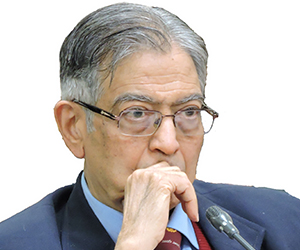The rapidity of Pakistan’s nuclear weaponisation in recent years has been under constant scrutiny in the United States and has been well-documented in articles in the ‘Bulletin of Atomic Scientists and the Nuclear Threat Initiative’ as well as in numerous reports of the Congressional Research Service (CRS). Regrettably, this does not appear to have been the subject of as much independent analysis and comment in India as in the US despite the fact that Pakistan’s nuclear weapon programme is clearly India-centric. Accordingly, the CRS’ latest report of June 26, 2012 titled ‘Pakistan’s Nuclear Weapons: Proliferation and Security Issues’ merits attention.
Addressing widespread apprehensions, particularly in the US, about the possibility of Pakistani nuclear weapons falling into the hands of jihadi elements, the report tends to suggest that Pakistan has put in place adequate security systems to obviate such a development. It, however, concedes that ‘the collapse or near-collapse of the Pakistani government is probably the most likely scenario in which militants or terrorists could acquire Pakistani nuclear weapons’. It may be recalled that much the same point had been made by former president Prevez Musharraf. The attacks by jihadi forces with inside help on Pakistani military bases, most notably at the Mehran Naval Base in May 2011 and recently at Kamra, would suggest that the possibility of nuclear weapons falling into the hands of militants is much higher than the CRS report would have us believe.
Significantly, the report places the Pakistani nuclear warhead stockpile at 90-110 as against 60-80 for India and suggests that vigorous moves are underway in order to effectuate a ‘quantitative and qualitative improvement in Islamabad’s nuclear arsenal’.
These assertions echo those made in a 2011 Hans Kristensen and Robert Norris report published by the Bulletin of Atomic Scientists which inter alia said that Pakistan has the world’s fastest growing nuclear stockpile and at current rates of expansion its 90-110 warheads could, over the next 10 years increase to 150-200 warheads; its stockpile of highly-enriched uranium and weapons-grade plutonium, as estimated by the International Panel on Fissile Material in 2010, were sufficient to produce 160-240 warheads; its current rate of production of fissile material is sufficient to produce 10-21 nuclear warheads annually. This capability will be enhanced as it is building two new plutonium production reactors and an additional plutonium reprocessing facility; its two squadrons of F16 A/B aircraft with a range of 1,600 kms have for long been earmarked for delivery of nuclear bombs. In March 2011 a new squadron of F16 C/D was also acquired for this role; it has three operational ballistic missiles: the Ghaznavi (Hatf-3, range under 400 kms), the Shaheen (Hatf-4, range over 450 kms) and the Ghauri (Hatf-5, range over 1,200 kms). In addition, it has three other ballistic missile systems likely to see early induction notably the Shaheen II (Hatf-6, range over 2,000 kms), the Abdali (Hatf-2, range 180 kms) and the Nasr (Hatf-9, range 60 kms). Pakistan is also developing two nuclear capable cruise missiles namely the ground launched Babur (Hatf-7, range 600 kms) and the air/sea launched Ra’ad (Hatf-8, range over 350 kms).
Unlike India, Pakistan does not have a ‘no-first-use’ policy and not only is its nuclear arsenal India-specific but also the threshold for its use is disturbingly low. This is corroborated by Pakistan’s focus on short range nuclear capable ballistic and cruise missiles. One may also refer to the interview given to the Landau Network, an Italian arms control organisation, in January 2002, by General Khalid Kidwai, the director general of the Strategic Plans Division of the National Command Authority of Pakistan wherein he indicated that Pakistan’s nuclear weapons were ‘aimed solely at India’ and would be used against it if India attacked Pakistan and conquered a large part of its territory, or if India destroyed a large part of either its land or air forces, or of India sought to strangle Pakistan’s economy or if India attempted to destabilise Pakistan’s polity or created large-scale internal subversion.
The rapidity of Pakistan’s India-centric nuclear weaponisation, the low threshold at it which it is likely to resort to a nuclear attack, its propensity to military adventurism, and its readiness to act as China’s cats paw, makes it incumbent upon us to ensure that the credibility of India’s nuclear deterrent is never in doubt. This calls for speedily undertaking a host of measures. India should think of enhancement and upgrade of its nuclear weapon arsenal with a view to inflicting unacceptable damage simultaneously on both Pakistan and China as they may well act in collusion. This would call for a nuclear warhead arsenal running at least into the low hundreds that can be launched from air, land and sea both by surface craft and submarines. Land-based missiles should be mobile and located in camouflaged and hardened shelters. A sufficiently large, diverse, and survivable nuclear arsenal is essential in order to deter an enemy from contemplating the resort to a nuclear attack.
The creation of a chief of defence staff in order to provide 24/7 leadership, guidance and oversight to our strategic forces command and to ensure the speedy development of an effective nuclear force must be done. Fail-safe procedures for the effective deployment and operation of our nuclear deterrent in all situations should be established. Alternative chains of command should me made fully functional so as to ensure an element of automaticity in the effectuation of a prompt and devastating retaliatory nuclear strike in the event of decapitation of our nuclear command authority.
Importantly, our ‘no first use’ policy needs to be tweaked by suggesting that if India is subjected to a nuclear attack by a country aided by a nuclear weapon state it would not merely react with nuclear weapons against the country, which initiated the attack, but may also do so against the abetting nuclear weapon state. Hopefully such a move may cause China to refrain from such collusive action with Pakistan and perhaps even induce it to act as a restraining influence on it.
Finally, the fact that India’s nuclear arsenal is being assiduously nurtured and that India has the political will to use it needs to be clearly signalled. The former can be achieved by holding regular meetings of the nuclear command authority and publicising the same as also the upgrade of our nuclear arsenal. The latter would be automatically signalled if we are uncompromising in addressing all security-related issues with firmness and despatch.
Published Date: 1st September 2012










Post new comment